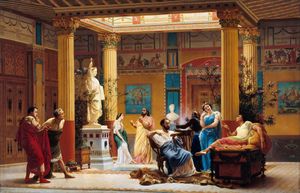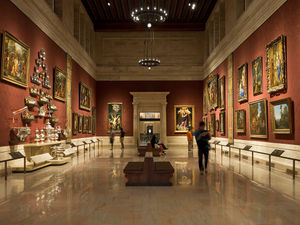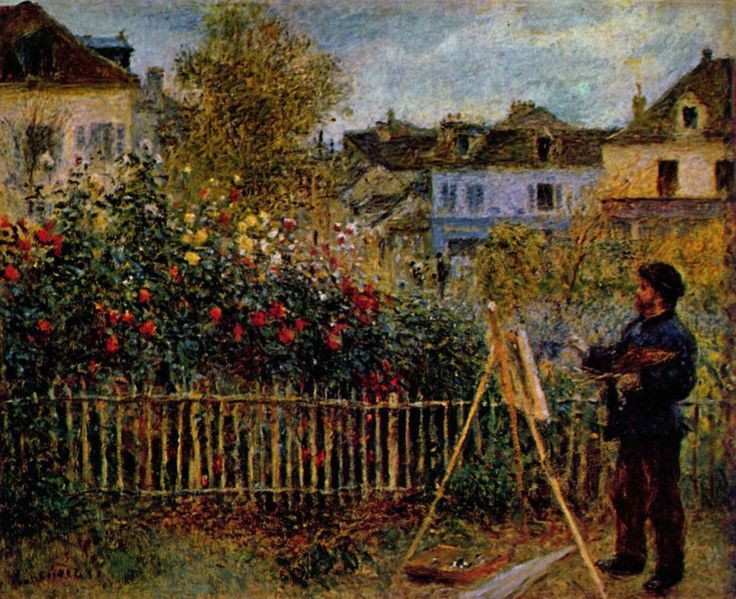Museum
A museum is a place or an institution that collects and displays items within one or more subject areas, such as natural science or visual art, usually for the purpose of education.
According to the definition of the International Council of Museums: "A museum is a non-profit making, permanent institution in the service of society and of its development, and open to the public, which acquires, conserves, researches, communicates and exhibits, for purposes of study, education and enjoyment, material evidence of people and their environment."
At present museums are expanding to include virtual exhibits.
The best introduction to art is to stroll through a museum. The more art you see, the more you'll learn to define your own taste. Jeanne Frank (Author).
The only way to understand painting is to go and look at it. And if out of a million visitors there is even one to whom art means something, that is enough to justify museums. Pierre-Auguste Renoir.
Give me a museum and I'll fill it. Pablo Picasso.
The role of a museum of modern art is to make a good selection and identify what we believe to be the coming movements, and that requires taste. David Rockefeller.
It's a lovely experience walking around a museum by yourself. Brad Pitt.
Types of museums

Several different types of museums are found throughout the world.
Archaeological museums
Art museums
History museums
Maritime museums
Natural History museums
Open-air museums
Science museums
Virtual museums


Art Museums around the world
(With links to official homepages of Museums and Galleries)
It is considered that the most important art museums are: Musee du Louvre, Paris, France, Vatican Museums, Vatican City, Rome, Italy, Metropolitan Museum of Art, New York, New York, J. Paul Getty Center, Los Angeles, California, Musee d'Orsay, Paris, France, Uffizi Gallery, Florence, Italy, Art Institute of Chicago, Chicago, Illinois, Tate Modern, London, England (part of the Tate group), Prado Museum, Madrid, Spain, and the National Gallery of Art, Washington, D.C. [1]

Also important are (alphabetical index):
- Alte Pinakothek, Neue Pinakothek and Pinakothek der Moderne, Munich.
- British Museum, London.
- Buehrle Collection, Zurich.
- Centre Pompidou, Paris.
- Chateau De Versailles, France. (there Le Musée de l’Histoire de France.)
- Clark Art Institute Williamstown, Massachusetts.
- Cleveland Museum of Fine Art.
- Corcoran Gallery of Art, Washington, DC.
- Courtauld Institute of Art, London.
- Detroit Institute of Arts.
- Fine Arts Museums of San Francisco.
- Fitzwilliam Museum, Cambridge, UK.
- Frick Collection, New York, NY.
- Galleria Borghese, Rome.
- Gemaldegalerie - Berlin.
- Gemäldegalerie der Akademie der bildenden Künste Wien., Vienna.
- Guggenheim Museum, New York.
- Isabella Stewart Gardner Museum. Boston, MA.
- Jewish Museum Berlin
- Kunsthistorisches Museum. Viena.
- Los Angeles County Museum Of Art.
- Liechtenstein National Museum.
- Museo Reina Sofia, Madrid.
- Musée de l’Orangerie, Paris.
- Musée Fabre, Montpellier, France.
- Museum of Fine Arts, Boston, MA.
- Museum of Fine Arts, Budapest.
- Museum of Fine Arts, Houston.
- Museum of Modern Art, New York.
- National Gallery, London.
- National Gallery, Berlin, part of the Berlin State Museums.
- National Gallery of Denmark.
- National Portrait Gallery, London.
- Norton Simon Museum, Pasadena, CA.
- Österreichische Galerie Belvedere, Vienna.
- Petit Palais, City of Paris Fine Art Museum.
- Pitti Palace, Florence.
- Philadelphia Museum Of Art.
- Rijksmuseum, Amsterdam.
- Smithsonian American Art Museum, Washington, DC.
- St. Louis Art Museum.
- The Museum of Islamic Art Doha, Qatar.
- The National Museum of Western Art, Tokyo.
- The State Hermitage Museum, St. Petersburg, Russia.
- The State Tretyakov Gallery, Moscow.
- Thyssen-Bornemisza Museum of Art, Madrid.
- Van Gogh Museum, Amsterdam.
- Victoria & Albert Museum, London.
- Wadsworth Aetheneum, Hartford, Connecticut.
- Worcester Museum, MA.
3 Highlight paintings at The National Gallery, London.
Claude Lorrain, Embarkation of Saint Ursula, 1641.
John Constable, The Haywain, 1821.
William Turner, The Fighting Temeraire, 1839.
Jacques-Louis David at the Louvre.
History
Originally, museums developed from the collections of rarities and pieces of which many European monarchs and gentlemen assembled in the 16th and 17th centuries. In the 18th century, it became common to put such collections in dedicated suites or buildings and make them accessible to select individuals.
The Capitoline Museums in Rome are a group of art and archaeological museums; it is the oldest public collection of art in the world; it began in 1471 during the Renaissance.
The first museum to offer more general, although still not universal, public access was the British Museum, which was established in 1753. The foundation for the British Museum was the extensive natural scientific and ethnographic collection of the scientist Sir Hans Sloane, who had bequeathed the collection for the purpose of creating such a museum.
The Musée du Louvre opened on 10 August 1793 with a collection of 537 paintings and 184 objects of art. Click for Aujourd'hui selected Masterpieces.
Articles about Museums in Conservapedia
The Louvre, The National Gallery, London, The National Gallery of Art, Washington, D.C., Paul Getty Museum, Metropolitan Museum of Art, British Museum, Musée d'Orsay, American Museum of Natural History, State Hermitage Museum, Tuvia Maizel Museum, National Museum of Natural History.
The Great Last Judgment, 1617, by Peter Paul Rubens at Alte Pinakothek, Munich, Germany.
See also
- Sculpture
- Painting
- World famous paintings
- Art cities
- Painting Galleries
- History of painting
- Famous Art Galleries



External links


- Famous Museums in the World.
- Top 10 Museums and Galleries.
- 14 Best Museums in the World.
- Museum Index.
- The Pushkin Museum of Fine Arts.
- Harvard Art Museums.
- Virtual Library museums pages. A distributed directory of on-line museums.
- International Museums. by ICOM.
- Museums - Mexico City.
- Museums in Latin America - LANIC. The University of Texas at Austin.
- Institute of Museum and Library Services Washington, D.C.
- The WebMuseum. by Nicolas Pioch.
- Olga's Gallery.


Monet painting in his garden in Argenteuil by Pierre-Auguste Renoir, 1873, at Wadsworth Atheneum Museum of Art, Hartford, CT..
MAKING ART WITH ART






















